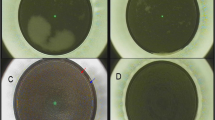Abstract
The purpose of this study was to evaluate the incidence of opaque bubble layer (OBL) in femtosecond laser-assisted in situ keratomileusis (LASIK) flaps created with the support of Visumax Carl Zeiss femtosecond laser, planned with different flap diameters (7.90, 8.0, and 8.20 mm) and the same laser energy and power settings. Incidence of intraoperative OBL in flaps of consecutive 108 patients (216 eyes) subjected to bilateral femtosecond-assisted LASIK was considered. Flap creation was performed with the same laser design parameters (spot distance and energy offset) and different presetting diameters of 7.90 mm (72 eyes, group 1), 8 mm (72 eyes, group 2), and 8.20 mm (72 eyes, group 3). The incidence of OBL was considered and its extension was reported measuring involvement of different four corneal flap quadrants in which was theoretically divided the entire flap area; based on these data, OBL presence was classified as none (no evidence of OBL), minimal (minimal presence in not more that one quadrants corneal flap), mild (OBL presence in almost two or three quadrants without tendency to invade central cornea), and moderate (OBL presence in almost three quadrants with tendency to invade central cornea). In group 1, the incidence of OBL was of 23.6 % (17 eyes) with a mild/moderate presence; in group 2, incidence was 20.8 % (15 eyes) with mild presence. Group 3 presented a reduced OBL incidence (4.1 %, 3 eye) with a minimal presence. No statistically significant difference was found between group 1 and 2 (p = 0.8414).We found statistically significant differences between group 1 and group 3 (p = 0.0012) and between groups 2 and 3 (p = 0.0044). A significant reduction and extension of OBL incidence were evident when LASIK flap settings diameter was increased, and flap edge was closer to the contact glass border; this is probably consequent to a more effective gas dispersion outside of corneal flap.






Similar content being viewed by others
References
Aristeidou A, Taniguchi EV, Tsatsos M, Muller R, McAlinden C, Pineda R, Paschalis EI (2015) The evolution of corneal and refractive surgery with the femtosecond laser. Eye Vis 2:12
Stern D, Schoenlein RW, Puliafito CA, Dobi ET, Birngruber R, Fujimoto JG (1989) Corneal ablation by nanosecond, picosecond, and femtosecond lasers at 532 and 625 nm. Arch Ophthalmol 107(4):587–592
Ratkay-Traub I, Ferincz IE, Juhasz T, Kurtz RM, Krueger RR (2003) First clinical results with the femtosecond neodymium-glass laser in refractive surgery. J Refract Surg 19:94–103
Soong HK, Malta JB (2009) Femtosecond lasers in ophthalmology. Am J Ophthalmol 147:189–197
Ratkay-Traub I, Juhasz T, Horvath C et al (2001) Ultra-short pulse (femtosecond) laser surgery: initial use in LASIK flap creation. Ophthalmol Clin North Am 14(2):347–355
Binder PS (2010) Femtosecond applications for anterior segment surgery. Eye Contact Lens 36(5):282–285
Sugar A, Rapuano CJ, Culbertson WW, Huang D, Varley GA, Agapitos PJ, de Luise VP, Koch DD (2002) Laser in situ keratomileusis for myopia and astigmatism: safety and efficacy: a report by the American Academy of Ophthalmology. Ophthalmology 109(1):175–187
Slade SG (2007) The use of the femtosecond laser in the customization of corneal flaps in laser in situ keratomileusis. Curr Opin Ophthalmol 18(4):314–317
Salomao MQ, Wilson SE (2010) Femtosecond laser in laser in situ keratomileusis. J Cataract Refract Surg 36:1024–1032
Morshirfar M, Gardiner JP, Schliesser JA, Espandar L, Feiz V, Mifflin MD et al (2010) Laser in situ keratomileusis flap complications using mechanical microkeratome versus femtosecond laser: retrospective comparison. J Cataract Refract Surg 36:1925–1933
Liu CH, Sun CC, Hui-Kang Ma D, Chien-Chieh Huang J, Liu CF, Chen HF, Hsiao CH (2014) Opaque bubble layer: incidence, risk factors, and clinical relevance. J Cataract Refract Surg 40(3):435–440
Courtin R, Saad A, Guilbert E, Grise-Dulac A, Gatinel D (2015) Opaque bubble layer risk factors in femtosecond laser-assisted LASIK. J Refract Surg 31(9):608–612
Jung HG, Kim J, Lim TH (2015) Possible risk factors and clinical effects of an opaque bubble layer created with femtosecond laser-assisted laser in situ keratomileusis. J Cataract Refract Surg 41(7):1393–1399
Kaiserman I, Maresky HS, Bahar I, Rootman DS (2008) Incidence, possible risk factors, and potential effects of an opaque bubble layer created by a femtosecond laser. J Cataract Refract Surg 34:417–423
Kanellopoulos AJ, Asimellis G (2013) Essential opaque bubble layer elimination with novel LASIK flap settings in the FS200 Femtosecond Laser. Clin Ophthalmol 7:765–770
Santhiago MR, Wilson SE (2012) Cellular effects after laser in situ keratomileusis flap formation with femtosecond lasers: a review. Cornea 31(2):198–205
Author information
Authors and Affiliations
Corresponding author
Ethics declarations
Conflict of interest
The article has not been presented in a meeting. The authors did not receive any financial support from any public or private source. The authors have no financial or proprietary interest in a product, method, or material described herein. No conflict of interest is present for all authors in this paper.
Rights and permissions
About this article
Cite this article
Mastropasqua, L., Calienno, R., Lanzini, M. et al. Opaque bubble layer incidence in Femtosecond laser-assisted LASIK: comparison among different flap design parameters. Int Ophthalmol 37, 635–641 (2017). https://doi.org/10.1007/s10792-016-0323-3
Received:
Accepted:
Published:
Issue Date:
DOI: https://doi.org/10.1007/s10792-016-0323-3




